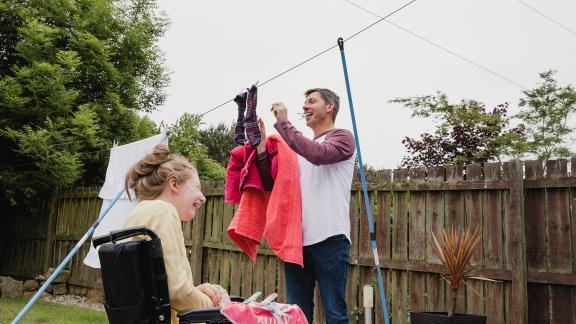Supporting integrated working through blended roles

The Greater Manchester (GM) adult social care transformation programme in the GM Integrated care system (ICS) established several trailblazer programmes to support people to live well at home across their locality. The programme focused on improving career pathways for the workforce across the system and providing better support for people, by integrating health and social care roles.
What the ICS faced
The main objective of the programme was to broaden career possibilities and aspirations as well as address the significant recruitment and retention issues.
People across the GM area who were accessing health and care reported a disjointed experience of care and support, a lack of person-centred conversation and poor communication between health and social care services. Additionally, the workforce faced significant challenges regarding pay, sickness absence rates and limited access to alternative career paths between health and social care.
GM ICS established this programme to explore better ways to improve integration across social care and health services. They focused on creating a workforce model that addressed the workforce challenges for home care and district nursing, and most importantly support people to live well in their own homes.
The design of the programme was a collaborative effort, bringing together district nurses, local authorities, independent sector social care providers, the voluntary sector, NHS, primary care and other sector experts.
What the ICS did
GM ICS supported a pilot programme in Tameside neighbourhood community services to determine the effectiveness of the blended roles programme. They developed new ways of working across teams which included:
- Closer day-to-day working of health and care teams.
- Weekly health and care planning meetings called safety huddles.
- Training of 50 home care workers to complete low-risk healthcare tasks, previously- completed by a district nurse (e.g., pressure care and eye drops).
- 40 people receiving care from both district nursing and social care were identified. Named team members were trained in the delivery of low-level/low-risk healthcare tasks, appropriate to only that individual’s care needs, with access to district nurse support, appropriate clinical governance, joint assessments and competency sign-off.
- Co-location and attendance at multi-disciplinary team meetings. Where possible providers spend more time in the neighbourhood office and attending team meetings.
- Implementation of joint health and care assessments for high intensity users.
- Development of a joint care plan care bundle.
Results and benefits:
Following the implementation in Tameside twelve staff members were surveyed who took part in the original blended roles programme. Survey responses highlighted that:
- All staff members agreed that these new ways of working have made a positive difference in the care they are able to provide.
- 92 per cent shared that they felt the new ways of working have made a positive difference in their job satisfaction.
Anecdotal evidence taken from programme participants suggests that people in the community accessing the health and care services impacted by the programme are reporting improvements in the quality of their care.
Better communication leads to reduced risk. Home care workers see the people they are treating every day, therefore, they are more likely to pick up on any changes in the individual’s physical and mental health. Prior to this programme these were often not reported or escalated. The programme created much better communication as home care workers are now trained to report any concerns to a district nurse.
Users benefit from having a single point of contact, which eliminates the need to repeat their issues to various individuals in different organisations. The waiting time for users needing interventions, such as those bedbound and requiring dressing changes, has been reduced. All care providers participating in the pilot commented that it was very likely they would recommend this project to other care home managers and new residents. Positive feedback was particularly received in relation to:
- better patient care
- improved relations between carer and residents
- easier to manage diabetes patients with cognitive issues
- improved development opportunities for staff
- fewer delayed /missed insulin doses.
“Things have really changed since the project began for myself and my clients as now we have the knowledge of what to look for and how to deal with it. Myself and my colleague have managed to keep all pressure areas under control without the need for a dressing or contacting the district nurses. We have a weekly meeting with district nurse at the client’s homes in which we share any concerns we may have had within that week, district nurses also do their weekly pressure checks.” - feedback from a home care worker from the original pilot.
Takeaway tips
Lessons from Tameside can help ensure the success of similar programmes in other regions. The top three tips would be:
- Committing to high-quality resources for six to eight months is necessary for successful program implementation. This includes design, training, and ensuring competency.
- A dedicated role in the district nursing team ensures ongoing resources for training and competencies.
- Success in the programme requires a shared vision among leaders of healthcare and social services, with a commitment to collaboration and utilising expertise towards a common goal.
To achieve success in changing work methods, it is crucial to involve the workforce. In Tameside, staff members and their representatives were engaged in every stage, from design workshops to training and competency assessments. Trade Union colleagues were kept informed throughout the process and collaborated on an engagement protocol.
Next steps
Scaling up across Greater Manchester
- The appointment of a blended roles coordinator in July 2021 enabled an expansion of the programme beyond Tameside, and into other areas across GM. All other nine localities are now involved in the programme, ranging from having had initial discussions to readiness to launch their own programme.
- An insulin administration training programme has been developed and is currently being rolled out in Tameside and other areas in GM. Accreditation for this is being sought.
- Collaborative work is underway with GM Cancer Academy to integrate continence care and catheter care training into the programme for care homes and home care.
Contact information:
Jo Finnerty, Programme Manager, Adult Social Care Workforce, NHS Greater Manchester Integrated Care- Jo.finnerty@nhs.net



